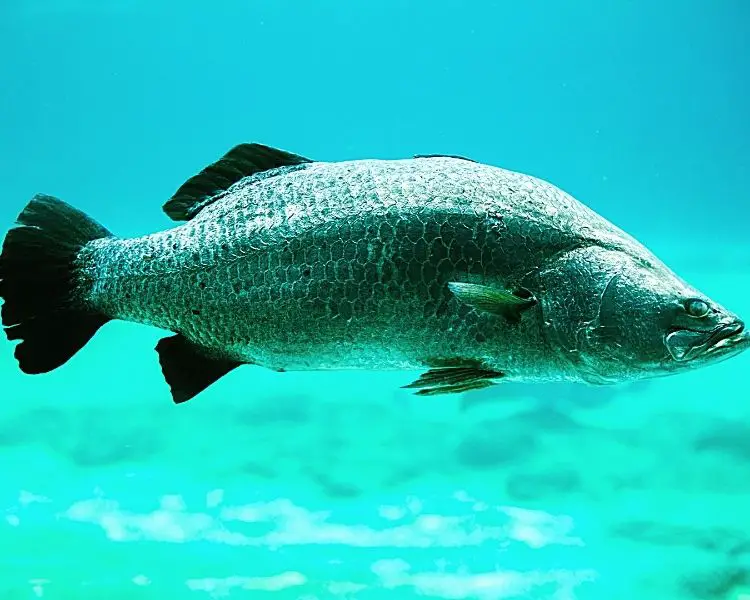Barramundi, also known as Sea Bass in Asia, is one of the most popular sporting fish species in Northern Australia. These hardy fish can be cultivated in freshwater or seawater, making them an excellent option for commercial farming. However, you may be wondering how long barramundi take to grow? We've consulted with some fish experts, and this was their reply.
The barramundi can grow to market size within six to twelve months, depending on their growing conditions. Once the barramundi fish spawns, the eggs hatch within eighteen hours, and the hatchlings start feeding two days later. Overall, barramundi grows relatively quickly.
Although the barramundi can reach legal selling size within six months, it continues to grow for much longer. Adult barramundi can grow up to 76 inches long, and they live for about twenty-five years. This article discusses the growth rate of barramundi and how to provide the ideal conditions for the barramundi to grow quickly.

How Long Does The Barramundi Fish Take To Grow?
The barramundi fish grow relatively quickly. Within six to twelve months after hatching, the barramundi can grow more than double in size and reach market size. However, at this stage, the barramundi are still relatively small. Barramundis have been known to grow as big as 76 inches long and weigh up to 133 pounds.
However, for the barramundi to grow this big rapidly, it needs a specific environment. Barramundi fish can tolerate various salinity levels and can be farmed in either freshwater or saltwater. In addition to the water's saline levels, however, other factors contribute to the growth rate of the barramundi:
These are the ideal growing conditions for barramundi to grow quickly. As these factors are crucial in the growth rate of a barramundi, we will explain them in further detail.

Various size of Barramundi Fish
1. Optimal Water Temperature For Growing Barramundi
Barramundi is a hardy fish. However, like all fish, barramundi get stressed under certain circumstances. Water temperatures that are too low are one of these circumstances. Research indicates the barramundi prefers water temperatures between 82 and 90°F. At this water temperature, the barramundi is active and has a good appetite.
However, suppose the water temperature is lower than 68°F. In that case, the barramundi will stop feeding, their growth will be stunted, and their health deteriorate. Although barramundi can survive in water as cold as 61°F and as hot as 95°F, these temperatures are not ideal. Therefore, you should aim to keep your growing tanks or ponds between 82 and 90°F.
2. Optimal Water pH Levels For Growing Barramundi
Maintaining good water pH levels is crucial for fish farming. Because the fish live in the water, they are sensitive to pH changes and can develop illnesses and diseases when exposed to water pH levels different from what they require. Barramundi are no exception.
Barramundi require water pH levels between 6.5 and 7.2. Suppose the water pH levels are below or above these parameters for extended periods. In that case, the health of the fish will decline, and they may also die.
Here is a table showing what happens to barramundi at different pH levels.
Water pH-levels | Effects on the barramundi |
|---|---|
4 | Acid death for barramundi |
4-5 | No reproduction in barramundi population |
5-6.5 | The slow growth rate of barramundi |
6.5-7.2 | Optimal growing conditions for barramundi |
8-10 | The slow growth rate of barramundi |
>11 | Alkaline death for barramundi |
As you can see, maintaining the ideal water pH level of 6.5 to 7.2 is critical in ensuring the barramundi feed well, reproduce, and continue to grow.
3. Optimal Water Salinity For Growing Barramundi
Although barramundi can survive in freshwater and seawater environments, they have preferred salinity levels for breeding and feeding. Ideally, aim to maintain a water salinity level of 0-36 ppt. Research indicates that this water salinity level will lead to faster-growing juvenile barramundi.
Suppose the water you are using to grow your barramundi has a significantly higher saline content. In that case, you should supplement the water with potassium. A study about the salinity of water and its influence on the growth and well-being of the barramundi was released on academia. You can read more about potassium supplementation and saline water there.
4. Optimal Diet For Growing Barramundi
Barramundi are carnivorous by nature and therefore need a diet high in protein. Wild barramundi will eat crustaceans, shrimp, and smaller fish. Therefore, when farming barramundi, you must ensure that their diet has good protein content. Many barramundis are fed a diet of specialized pellets, worms, and fish scraps.
In addition to ensuring the barramundi have enough protein in their diet, you must also ensure they have enough vitamins. Barramundis are susceptible to many fish diseases, including Barramundi Nervous Necrosis Virus (BNNV) and BEV. Therefore, the barramundis need to have sufficient vitamins in their diets to ensure their immune systems remain strong, reducing the chance of getting infected.
Now that we've discussed the factors that contribute to how long it takes to grow the barramundi, we can discuss the growing phases of the barramundi.
Growing Phases Of The Barramundi
Barramundis have a few growing phases. However, these phases occur pretty quickly. You can have a harvest-size barramundi within six months to two years from hatching.
The first phase is right after the barramundi fingerlings have hatched. Fingerlings are between one and three inches long and will stay in the swamps where they hatched for a few months, then move into the freshwater areas of rivers, creeks, or river mouths.
Juvenile barramundi will remain in the freshwater environments for about three or four years; when they are between 23 and 27 inches long, they will move downstream to spawn during the mating season. Here they will remain until they are about six to eight years old, or between 33 and 40 inches long.
At this time, the barramundi will change sex to female and will then continue to breed until their death. Barramundi can live up to 25 years, and a single female can produce up to 40 million eggs during a single spawn.
This is great for farming purposes, as you only need a small initial barramundi population to start farming. Then, under the right conditions, you can begin harvesting the barramundi after one or two years. At this time, they will be the perfect marketable size.
Conclusion
Barramundis are hardy fish that can tolerate both saline and freshwater. They grow quickly in ideal conditions and can be harvested within a year or two of hatching. Water temperature, water pH levels, water salinity, and food quality influence the growth rate of the barramundi.
Interestingly, barramundi change their sex after about five years, changing from male to female. Barramundi are also highly fertile and thus a great fish to farm
Sources:


